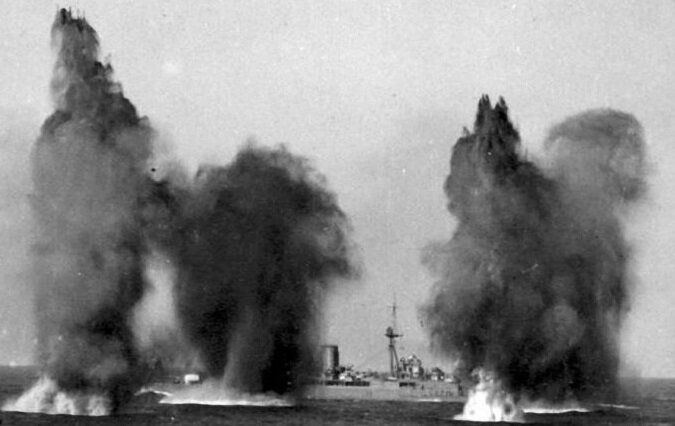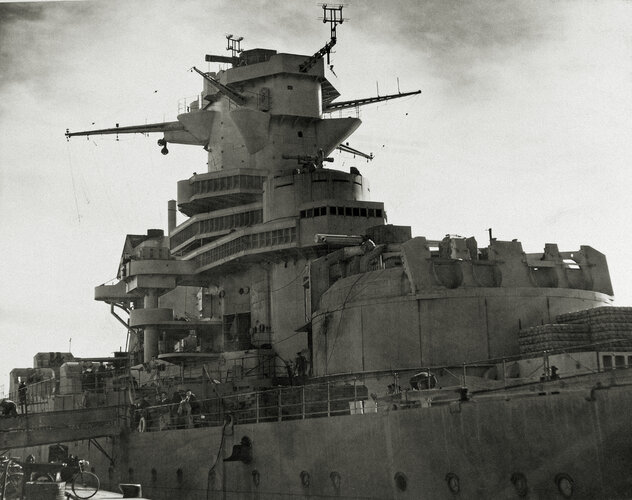As said in the tin. A short TL I posted on another forum.
June 18, 1940
The unfinished Jean Bart battleship make a daring escape from Nantes. Its captain, Ronarc'h, hesitates between
a) going to Cablanca (as he did OTL, alas !)
b) going to Clyde estuary, Scotland, as were his orders before June 11, 1940 (can you believe that ?).
That day he hear De Gaulle call and (unlike OTL, again !) decides to bring his unfinished battleship to Great Britain
1941-42
Ark Royal is sunk, the first Illustrious class ships are eviscerated by Stukas or bombed during Pedestal. Facing crippling losses the FAA / RN decides to finish the Jeant Bart as a carrier. It is big and fast and armored enough to make an honest-to-God substitute to an Illustrious. A stopgap.
De Gaulle and the Free French are extactic at the idea.
1944
Jean Bart carrier is part of Dragoon, southern France. Later, with its former sistership Richelieu, they will be part of the British BPF.
1946
A ruined France is more than happy to have the Jean Bart as carrier... alas, in order to pay for it, Richelieu has to go into mothball. It will be actually cannibalized to get its half sistership going.
1947
France buy the Colossus-class "Arromanches" as per OTL. With Jean Bart, plus the tiny Dixmude and the antiquated, cranky Béarn carrier (used as aircraft transports), they will make rotations to support the Indochina war until 1954.
1947-49
The failure of PA28 force the French Navy to seek not Lafayette and Bois belleau as per OTL but another Arromanches, that is, another Majestic / Colossus.
The one and only available is HMS Leviathan, so the deal is a go.
Meanwhile thanks to the Jean Bart being a potent carrier, France tries its hand at naval fighters.
1952
Naval fighter end results
VG-90: two build, two crash, two pilot dead.
NC-1080: one build, one crash, one pilot dead.
Nord 2200: nobody died, but it flies like a led brick.
Same for Dassault navalized MD-450M "Trombe" (= "Sea Ouragan !")
The last two are nonetheless tried onboard Jean Bart. But the French Navy goes instead chopping in GB, taking a DH Sea venom licence: the SNCASE Aquilon, of which 121 are procured.
1954
PA54 / 55 are more successfull than old PA28. Foch and Clemenceau are started. They will have the Audacious class BS-5 catapult - the 46 m long one.
The Jean Bart sheer size and capability however, drive the new carriers upwards, and they end at 40 000 tons, just big enough to get the full length BS-5, all 61 m of it.
Meanwhile discussing catapults the French discover the angled deck and mirror. They ask the British to modifiy, not the Arromanches as per OTL, but the far more capable Jean Bart.
And in the process, guess what happens ?
...the French become aware of the 1954-56 Medium Fleet Carrier study... that fits Foch, Clemenceau and future PA58 Verdun, like a glove. Right at 45 000 tons. Discussions are started for "joint carriers" (go to hell, CVA-01 !)
1956
The Suez crisis while a humiliating failure, as per OTL, has the Jean Bart, Arromanches and Leviathan, (the former carrying Aquilons, not F4U Corsairs like the other two), operating along the RN carrier fleet and notably their own Colossus and Majestics. This only encourage the two navies looking into further collaboration.
Upgrade of the J.B in Great Britain is a go.
1959
The modified Jean Bart, now with an angled deck and other goodies, re-enter service. The Jeanne d'Arc helocarrier enter service.
1961 Clemenceau enter service, followed by Foch in 1963.
Unlike OTL Arromanches, Jean Bart is fast enough (30 kt vs 24 kt) to operate along them.
Unlike OTL Lafayette (not procured ITTL), it is not only fast enough (30 kt) but also very long (255 m) so it can handle naval jet fighters.
1965
Arromanche and Léviathan are gone, replaced by Foch and Clemenceau. Jean Bart capabilities, compared to OTL Arromanches (that was not retired until 1974 OTL) are formidable. It can follow Foch and Clem' at 30 kt (Arromanches was 24 kt) it has twice the tonnage.
As such, it becomes one of the largest LPH in the world. The ship is upgraded once again, receiving the bulky MASURCA system planned for the smaller Jeanne d'Arc. At thrice the tonnage (36 000 tons instead of 12 000 tons) Jean Bart has no issue finding room for the SAM system. It becomes somewhat similar to the Soviet and Italian LPH - Doria, Venetto, Moskva - except at twice the tonnage.
Its new missions are
- LPH, with Super Frelons and Pumas
- ASW carrier - its hydraulic catapult can still handle Alizée aircraft, plus ASW helicopters like the Lynx.
- Naval pilot training - with CM-175 Zéphyr, a navalized Magister
- local air defense, Masurca
As a very last resort, Etendard IVs can operate out of Jean Bart, but not the Crusaders, which are already a tight fit on the more modern carriers. Also the lack of steam catapult (the old hydraulic one has been retained) limits Etendard operations.
By 1974 the question of retiring the ship arise... except the Soviets put the Kiev in service. So Jean Bart receives Crotale SAMs and, most importantly, Exocet missile boxes.
The ship is retired in 1992, being as old, if not even older, than the US Midway class carriers.
June 18, 1940
The unfinished Jean Bart battleship make a daring escape from Nantes. Its captain, Ronarc'h, hesitates between
a) going to Cablanca (as he did OTL, alas !)
b) going to Clyde estuary, Scotland, as were his orders before June 11, 1940 (can you believe that ?).
That day he hear De Gaulle call and (unlike OTL, again !) decides to bring his unfinished battleship to Great Britain
1941-42
Ark Royal is sunk, the first Illustrious class ships are eviscerated by Stukas or bombed during Pedestal. Facing crippling losses the FAA / RN decides to finish the Jeant Bart as a carrier. It is big and fast and armored enough to make an honest-to-God substitute to an Illustrious. A stopgap.
De Gaulle and the Free French are extactic at the idea.
1944
Jean Bart carrier is part of Dragoon, southern France. Later, with its former sistership Richelieu, they will be part of the British BPF.
1946
A ruined France is more than happy to have the Jean Bart as carrier... alas, in order to pay for it, Richelieu has to go into mothball. It will be actually cannibalized to get its half sistership going.
1947
France buy the Colossus-class "Arromanches" as per OTL. With Jean Bart, plus the tiny Dixmude and the antiquated, cranky Béarn carrier (used as aircraft transports), they will make rotations to support the Indochina war until 1954.
1947-49
The failure of PA28 force the French Navy to seek not Lafayette and Bois belleau as per OTL but another Arromanches, that is, another Majestic / Colossus.
The one and only available is HMS Leviathan, so the deal is a go.
Meanwhile thanks to the Jean Bart being a potent carrier, France tries its hand at naval fighters.
1952
Naval fighter end results
VG-90: two build, two crash, two pilot dead.
NC-1080: one build, one crash, one pilot dead.
Nord 2200: nobody died, but it flies like a led brick.
Same for Dassault navalized MD-450M "Trombe" (= "Sea Ouragan !")
The last two are nonetheless tried onboard Jean Bart. But the French Navy goes instead chopping in GB, taking a DH Sea venom licence: the SNCASE Aquilon, of which 121 are procured.
1954
PA54 / 55 are more successfull than old PA28. Foch and Clemenceau are started. They will have the Audacious class BS-5 catapult - the 46 m long one.
The Jean Bart sheer size and capability however, drive the new carriers upwards, and they end at 40 000 tons, just big enough to get the full length BS-5, all 61 m of it.
Meanwhile discussing catapults the French discover the angled deck and mirror. They ask the British to modifiy, not the Arromanches as per OTL, but the far more capable Jean Bart.
And in the process, guess what happens ?
...the French become aware of the 1954-56 Medium Fleet Carrier study... that fits Foch, Clemenceau and future PA58 Verdun, like a glove. Right at 45 000 tons. Discussions are started for "joint carriers" (go to hell, CVA-01 !)
1956
The Suez crisis while a humiliating failure, as per OTL, has the Jean Bart, Arromanches and Leviathan, (the former carrying Aquilons, not F4U Corsairs like the other two), operating along the RN carrier fleet and notably their own Colossus and Majestics. This only encourage the two navies looking into further collaboration.
Upgrade of the J.B in Great Britain is a go.
1959
The modified Jean Bart, now with an angled deck and other goodies, re-enter service. The Jeanne d'Arc helocarrier enter service.
1961 Clemenceau enter service, followed by Foch in 1963.
Unlike OTL Arromanches, Jean Bart is fast enough (30 kt vs 24 kt) to operate along them.
Unlike OTL Lafayette (not procured ITTL), it is not only fast enough (30 kt) but also very long (255 m) so it can handle naval jet fighters.
1965
Arromanche and Léviathan are gone, replaced by Foch and Clemenceau. Jean Bart capabilities, compared to OTL Arromanches (that was not retired until 1974 OTL) are formidable. It can follow Foch and Clem' at 30 kt (Arromanches was 24 kt) it has twice the tonnage.
As such, it becomes one of the largest LPH in the world. The ship is upgraded once again, receiving the bulky MASURCA system planned for the smaller Jeanne d'Arc. At thrice the tonnage (36 000 tons instead of 12 000 tons) Jean Bart has no issue finding room for the SAM system. It becomes somewhat similar to the Soviet and Italian LPH - Doria, Venetto, Moskva - except at twice the tonnage.
Its new missions are
- LPH, with Super Frelons and Pumas
- ASW carrier - its hydraulic catapult can still handle Alizée aircraft, plus ASW helicopters like the Lynx.
- Naval pilot training - with CM-175 Zéphyr, a navalized Magister
- local air defense, Masurca
As a very last resort, Etendard IVs can operate out of Jean Bart, but not the Crusaders, which are already a tight fit on the more modern carriers. Also the lack of steam catapult (the old hydraulic one has been retained) limits Etendard operations.
By 1974 the question of retiring the ship arise... except the Soviets put the Kiev in service. So Jean Bart receives Crotale SAMs and, most importantly, Exocet missile boxes.
The ship is retired in 1992, being as old, if not even older, than the US Midway class carriers.
Last edited:



